Wondering which tool is right for you?
When looking for a powerful automation platform, you’ve got a lot of decisions to make. How do you know which one will be the best fit for your business’ unique needs? Do you need simplistic, easy-to-use features or a tool that takes longer to learn and implement to handle the needs of an enterprise business?
Whether you’re looking for intuitive automation, CRM functionality, or in-depth reporting, both ActiveCampaign and Salesforce can fit the bill. The reality is that you’re choosing between an expensive, more cumbersome tool and a flexible tool that can do whatever you need it to do without breaking the bank.
Let’s take a look at the features these platforms offer, who they’re best for, what they’ll cost you, and help you select the one that’s right for you.
ActiveCampaign: the features you need to help you grow
Founded in 2003, ActiveCampaign is an automation platform that gives you the power to automate your marketing communications, grow your sales pipeline, and send beautiful, personalized emails to your customers. They’ve established themselves as one of the best platforms for advanced automation in the email marketing space and offer powerful features for a competitive price.
| 93.4% deliverability rate | 250+ email marketing templates |
|---|---|
| 950+ integrations | 120k monthly email sends on Pro |
ActiveCampaign is a great fit for both small and large businesses because it offers the tools you need without overwhelming you with unnecessary extras. Its pros include advanced email marketing, powerful automation, easy-to-use features, and a smart CRM that helps you easily keep contact information up-to-date. Combining email, automation, and CRM, ActiveCampaign is a platform that any size team can use to scale their business and drive revenue.
ActiveCampaign is also #1 in email deliverability, scoring 93.4% and beating out all other email marketing platforms.

This means that more of your contacts will see the emails you send, increasing your chances of interaction (and hopefully conversion). This proves that ActiveCampaign is the go-to email platform if you care about deliverability and driving revenue. And you should, because an undelivered or lost to the spam folder email is practically useless.
Plus, compared to Salesforce, ActiveCampaign is easier (and faster) to set up, giving you more time to focus on building automations, integrating existing tools, and building smart content that reaches your customers at the perfect time. Once you're up and running, it’s a great choice for businesses looking to create consistent and effective marketing campaigns across multiple channels.
When you switch from to ActiveCampaign, enjoy free 1:1 migration
Adopting a new or switching to another platform can be an undertaking, but it’s inevitable if you’re hitting certain limits with your current tool. When you sign up for an ActiveCampaign Pro or Enterprise plan, we’ll migrate your email lists, transfer your templates, rebuild your automations, and set up your forms and landing pages. All for free.
You’ll get one-on-one sessions with a real person along with resources like help articles and our community to get you set up fast.
ActiveCampaign also provides 24/7 live chat and email support, ensuring you can get help whenever you need it. Their extensive resource library includes webinars, detailed guides, and a community forum, offering a wealth of information to help you navigate and optimize the platform.
Additionally, ActiveCampaign offers one-on-one training sessions for those who prefer a more personalized touch, making it easier to get tailored guidance and support.
Salesforce: built for large organizations with big budgets
Salesforce is a massive player in the CRM world. Founded in 1999, they’ve evolved from a straightforward CRM solution to a full-blown ecosystem of tools for businesses, especially large ones, to manage everything related to customer data, interactions, and marketing efforts. At its core, Salesforce helps companies streamline their sales, marketing, and customer service processes.
In terms of email marketing and automation, Salesforce’s Marketing Cloud is packed with tools for creating email campaigns and automating customer journeys. They also acquired Pardot, specifically designed for B2B marketing automation, which is now their Marketing Cloud Account Engagement product that combines automation, lead generation, nurturing, and tracking ROI for sales cycles.
| Basic email marketing templates | 3,000+ integrations |
|---|---|
| Basic marketing automation | Pricey add-ons and extra fees |
Salesforce is often known for its CRM that allows companies to manage leads, track sales opportunities, and view customer interactions all in one place. Their CRM tools integrate seamlessly with other Salesforce products, giving a full view of customer data that marketing and sales teams can access and use.
Salesforce is typically best for medium to large businesses, especially those with complex sales processes or those needing a high degree of customization. Companies that prioritize data-driven marketing and need deep automation will also find a lot to love here.
Smaller businesses or those just starting may find Salesforce a bit overwhelming. Their dozens of product offerings can be confusing and are usually much more expensive than other tools that can do the same thing for less.
FYI: This comparison will focus specifically on Salesforce’s Marketing Cloud Account Engagement Growth tier and ActiveCampaign’s Pro plan.
How do ActiveCampaign and Salesforce compare?
ActiveCampaign and Salesforce are two very different tools and naturally have some key differences. Let’s look at what real users are saying about each platform.
| ActiveCampaign | Salesforce | |
|---|---|---|
| Ease of admin | 8.4 | 7.9 |
| Quality of support | 8.6 | 7.4 |
| Product direction | 8.3 | 7.3 |
| Lead nurturing | 8.6 | 8.1 |
| Reporting | 8.2 | 7.4 |
| Performance and reliability | 8.5 | 8.1 |
| Integration APIs | 8.3 | 7.7 |
| Segmentation | 8.6 | 8.0 |
| Building and personalizing emails | 8.8 | 8.0 |
Source: G2
The main differences:
- Ease of use vs. customization: ActiveCampaign is designed for efficiency, making it a great fit for small to medium-sized teams that want to set up and manage email marketing, automation, and customer journeys without hassle. In contrast, the Salesforce Growth tier offers features for companies needing a more tailored approach with in-depth setup and specialized support.
- Ideal audience size and complexity: ActiveCampaign is a solid choice for businesses looking to streamline customer journeys and automate marketing for diverse audiences. Salesforce’s Account Engagement, however, is especially suited for larger organizations and B2B companies that have longer sales cycles, aren’t worried about budget, and may need additional features to manage the entire marketing/sales motion of their organization.
Marketing automation: powerful features vs. the same features for 7x the price
ActiveCampaign is known for their marketing automation. With features like automated email sequences, behavior-based triggers, segmentation, and lead scoring, marketers can tailor messages based on a customer’s interactions and interests. ActiveCampaign’s platform is also intuitive, enabling teams to set up complex, multi-step workflows without a steep learning curve.
Let’s take a look at a few key marketing automation features you can expect from ActiveCampaign.
A/B testing automations
ActiveCampaign allows you to A/B/C/D/E test entire workflows to see which sequence performs better. You can test different email paths, timing, or messages and compare which version drives more engagement or conversions.

This feature helps you continuously improve your automations by finding the most effective ways to guide users through the customer journey.
Salesforce’s Growth tier offers A/B testing options specifically geared toward optimizing emails. With this plan, you can create two versions of an email to test different elements—like subject lines, copy, or images—on a segment of your audience. Once you’ve set the criteria for a "winner" (usually based on open or click rates), the winning version is automatically sent to the remaining audience.

Salesforce also offers reporting insights to show what worked, which can help refine future campaigns. While it’s not as broad as the A/B testing in Salesforce’s full Marketing Cloud, it’s an efficient way for marketers to improve email performance over time.
AI campaign builder and predictive content
ActiveCampaign allows you to generate an entire campaign with the help of ActiveCampaign’s intuitive AI. This includes using AI to build automations and generate images.

Plus, the platform uses machine learning to tailor email content automatically based on each contact’s past behavior. This way, contacts see the content most likely to resonate with them, improving relevance without extra manual work.
This is especially useful for large, diverse contact lists where different segments may respond best to unique types of content.
Salesforce’s Growth tier does not offer predictive content.
Automation building
ActiveCampaign’s visual automation builder makes it easy to see complex workflows. You can add actions like “wait,” “if/then” logic, and triggers to shape each contact’s path.

This allows for conditional flows based on specific behaviors, like page visits or specific clicks, making it perfect for in-depth customer journeys.
Salesforce’s Growth tier does not offer advanced automation, personalization, and qualification. If you’d like a plan that includes an automation builder, you’ll have to upgrade to their Plus tier, costing you $2,750/month.
With the Plus tier, you have access to their Journey Builder, which allows you to create automated customer journeys that guide contacts through a series of interactions based on their behavior and preferences. It includes a drag-and-drop interface to easily design complex workflows without needing coding skills.
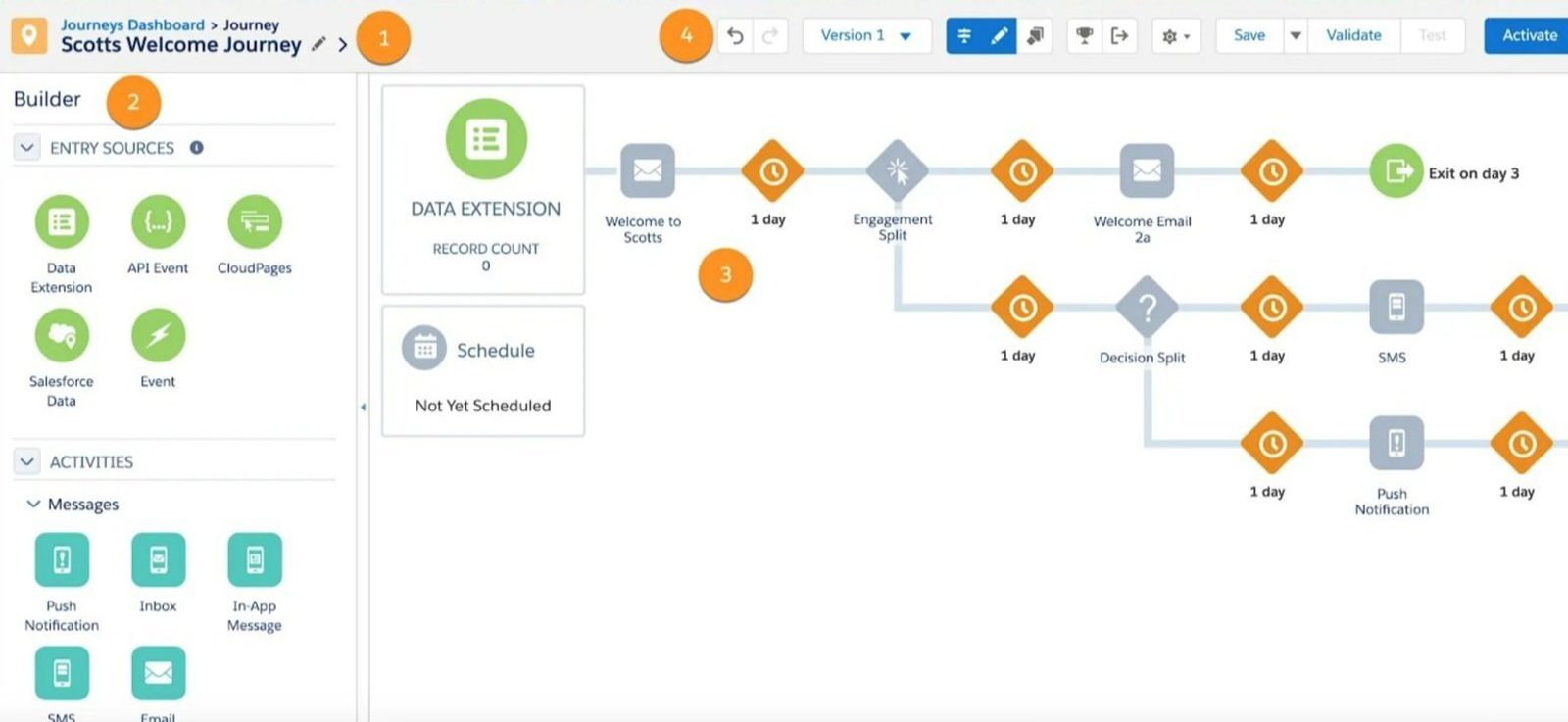
Plus, you can use event-based triggers to start journeys based on user actions, such as email opens, link clicks, or website visits.
You’ll also have access to their automation studio, a powerful tool that enables you to automate marketing tasks across multiple channels. The studio automates data imports and exports to keep your marketing lists up-to-date and includes scheduled automations so you can set specific times for tasks to occur.
Sales automation: fully integrated vs. adding another monthly fee
ActiveCampaign’s sales automation tools are designed to streamline sales processes, keep teams organized, and save a ton of time so you can focus more on closing deals and less on repetitive tasks. Let’s break down a few key sales automation features that you can expect from ActiveCampaign.
Automated deal management
ActiveCampaign allows you to set up automated workflows for managing deals, which means that when a lead takes a certain action—like submitting a form, opening a specific email, or clicking a link—they can automatically be assigned a deal status or even moved through different stages of the sales pipeline.

How you’d use it: Say a prospect fills out a request for a demo. You can set up an automation that automatically creates a new deal for that contact in your pipeline, assigns it to a salesperson, and sends them a notification.
By automating these steps, sales teams don’t have to worry about manually moving deals or assigning leads, which minimizes human error and ensures every lead is properly handled.
Automated task creation
This feature lets you create tasks automatically based on a contact’s activity or deal stage. For instance, if a lead moves into the “Qualified” stage, you can set an automation to create a follow-up task for the salesperson.
How you’d use it: Imagine a lead has been inactive for a while. You can set up an automation that creates a follow-up task after a certain number of days, so no leads go cold. Sales reps don’t need to remember every task themselves and follow-ups happen consistently, which can lead to better conversion rates.
Lead scoring
ActiveCampaign’s lead scoring assigns points to contacts based on their interactions with your brand (like email opens, clicks, website visits, etc.), helping you prioritize leads who show more interest.
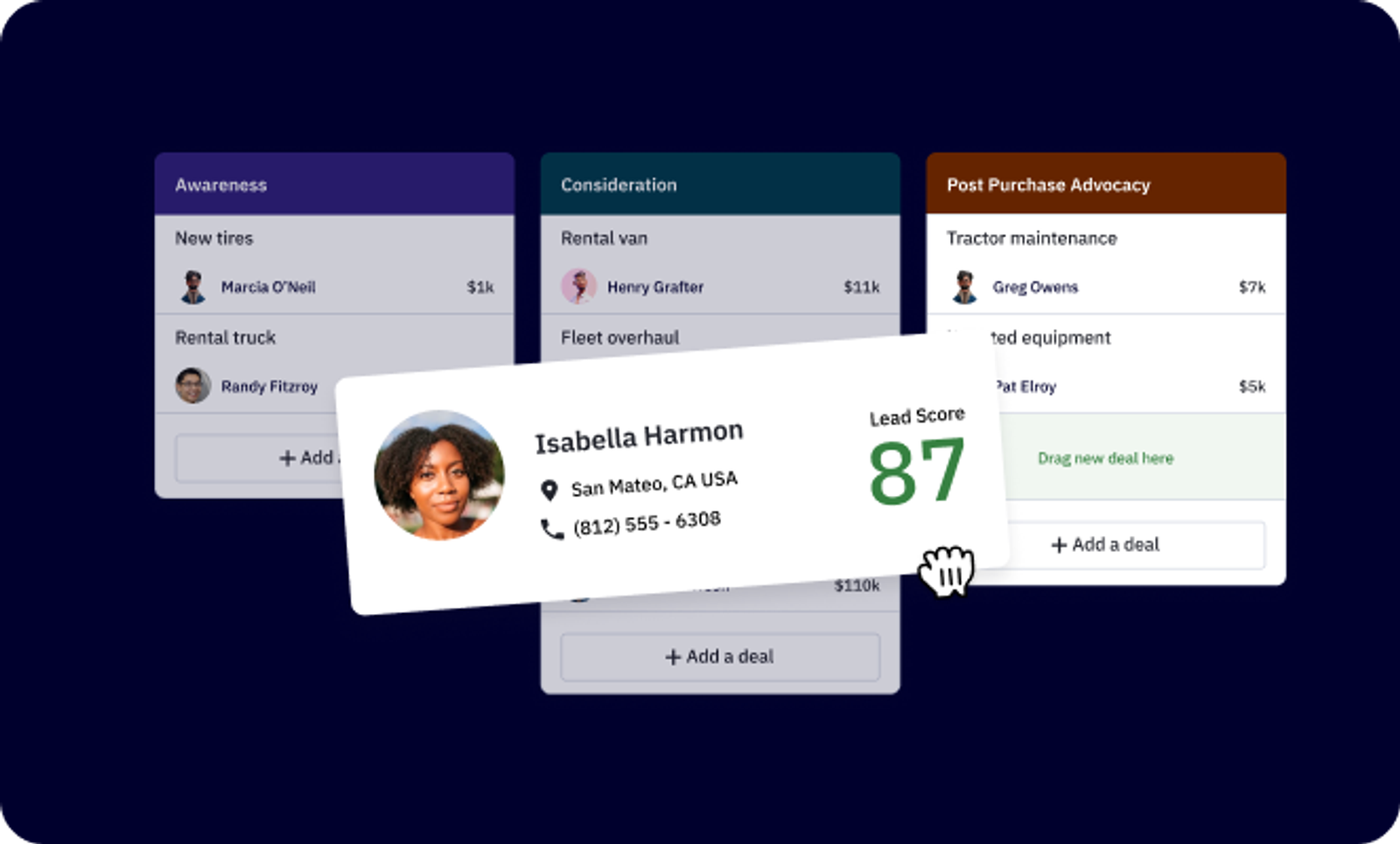
How you’d use it: Set up scoring rules so that, for example, every email opened is worth five points, and a page visit is worth 10 points. When a contact reaches a high score, you can create an automation that notifies the sales team to follow up. This lets you focus on the most engaged leads, so sales teams spend time on people most likely to convert.
Automated lead assignment
With ActiveCampaign, you can automatically assign leads to specific team members based on certain rules you set, like territory, lead score, or source.
How you’d use it: If you have a large sales team or specific reps assigned to different regions, you can set up lead assignment rules that automatically route leads to the right person. This ensures leads don’t fall through the cracks and go directly to the most relevant team member, speeding up the response time and helping you better serve the customer.
Win probability
No more guesswork. In ActiveCampaign, you can analyze past deal data to calculate the probability of winning a particular deal based on similar characteristics and behaviors.
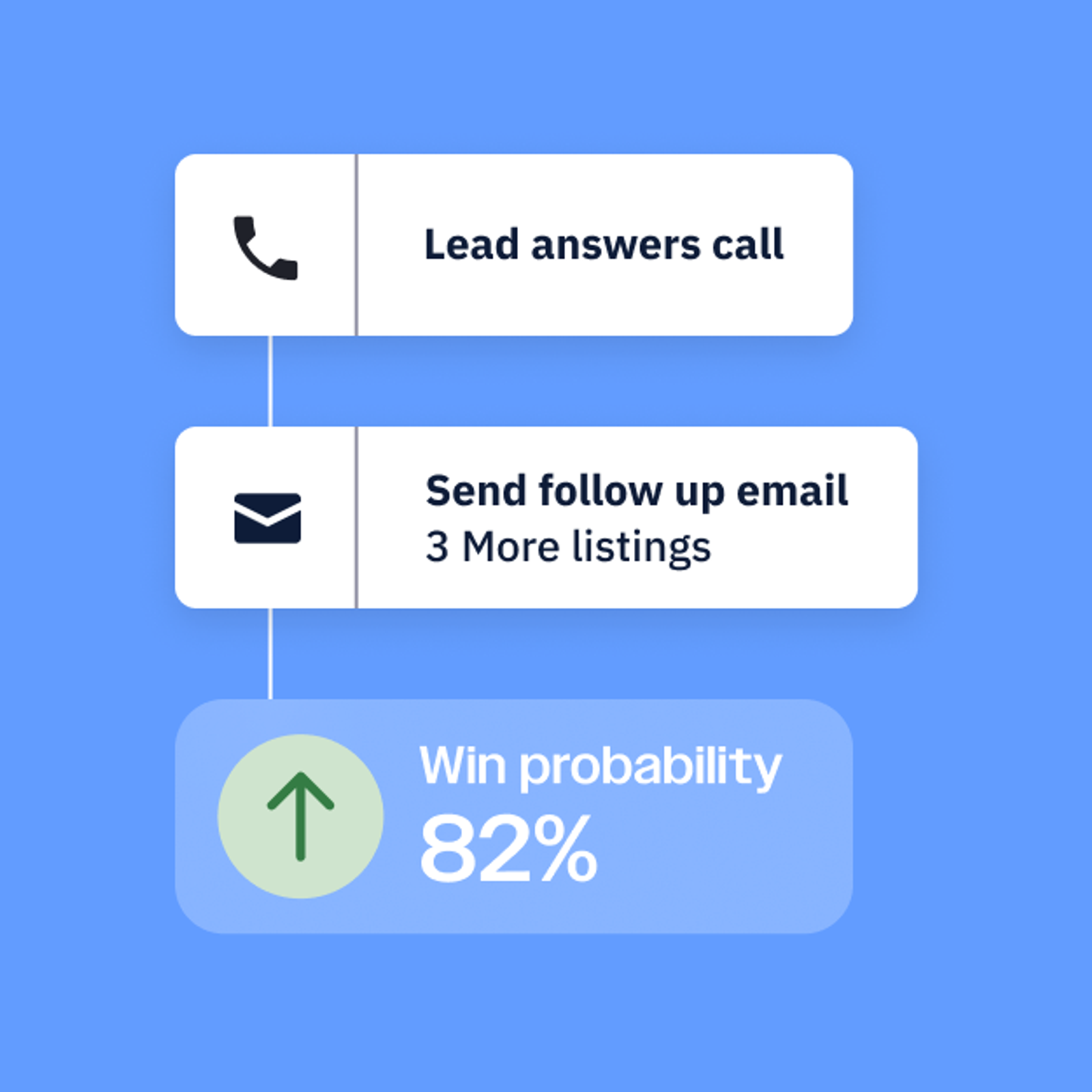
How you’d use it: You can check each deal’s win probability to help prioritize which ones need extra attention. This is especially helpful because sales reps get insights into which deals are most likely to close, allowing them to prioritize their time and efforts where it matters most.
Automation templates
ActiveCampaign offers an extensive library of automation templates that cover a wide range of marketing and sales needs, making it easy to get started with automated workflows. These templates are designed for common tasks like welcome sequences, lead nurturing, abandoned cart recovery, post-purchase follow-ups, win-back campaigns, and more.
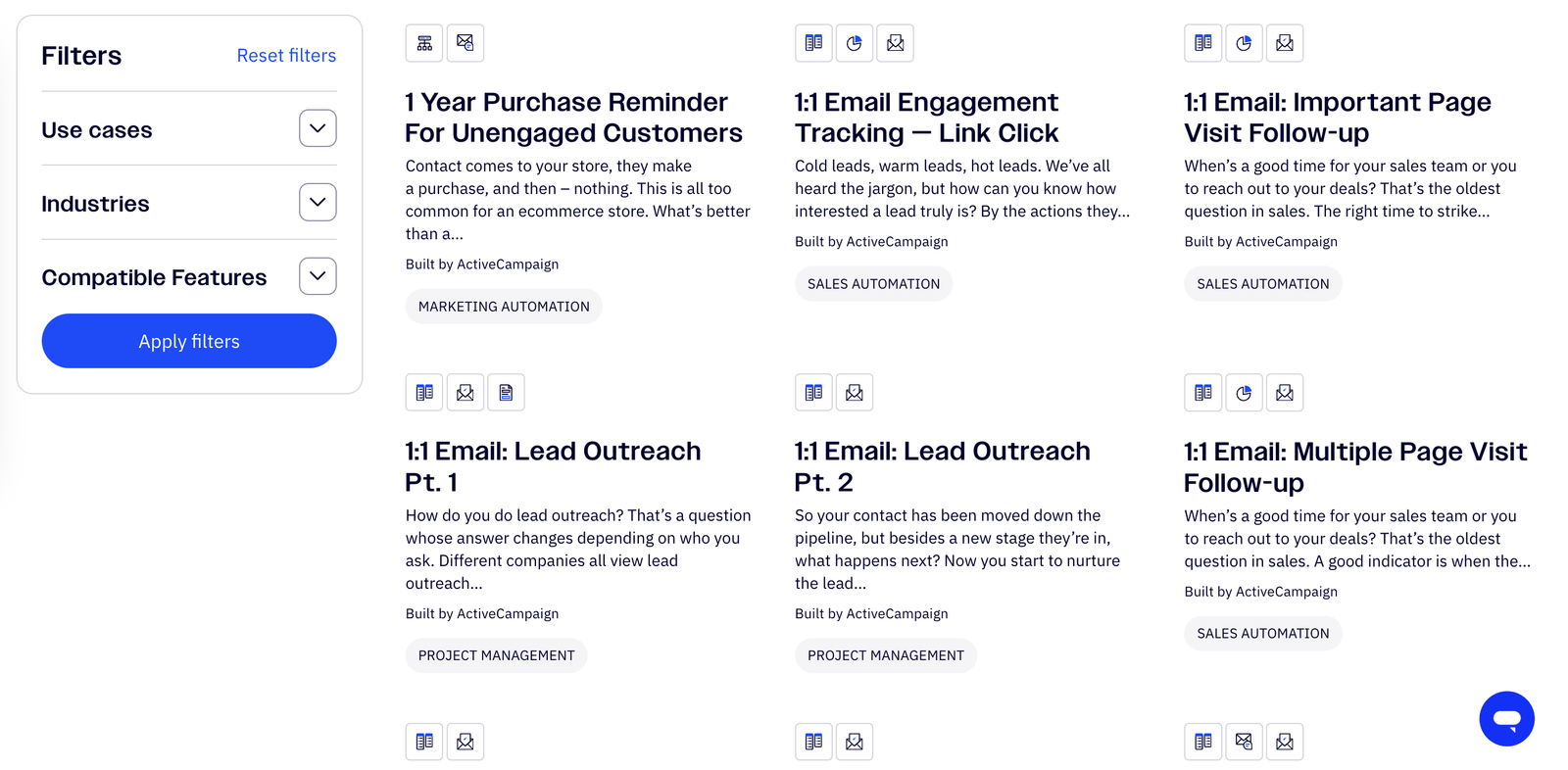
Each template provides a ready-made structure, complete with suggested triggers, actions, and conditions, so you can quickly customize them to fit your specific goals.
For instance, the welcome email sequence template helps new subscribers get familiar with your brand, while the lead scoring template automatically assigns scores to contacts based on engagement, enabling you to prioritize leads. There are also templates for customer journeys that incorporate multiple channels (like email, SMS, and site tracking), which is useful if you’re aiming for a cohesive experience across different touchpoints.
These features make ActiveCampaign a great choice for sales teams looking to increase their efficiency, keep organized, and move leads through the pipeline. Plus, because the automations are customizable, you can adapt each one to fit your team’s specific processes.
Salesforce Marketing Cloud Account Engagement does offer some tools that can assist sales teams, but it’s primarily designed for B2B marketing automation rather than dedicated sales automation.
Account Engagement allows you to set up automated engagement programs, use lead scoring to prioritize prospects, and create alerts for sales reps when a lead becomes more active. Additionally, it allows marketers to use automation rules to define actions that should take place based on lead behavior, such as assigning leads to specific sales reps based on engagement levels.
While these features support sales, Marketing Cloud Account Engagement lacks direct sales automation tools such as deal pipelines and sales task automation. To be able to use Salesforce as both a marketing and sales automation tool as you would ActiveCampaign, you’ll have to purchase Salesforce Sales Cloud, which starts at $25/month.
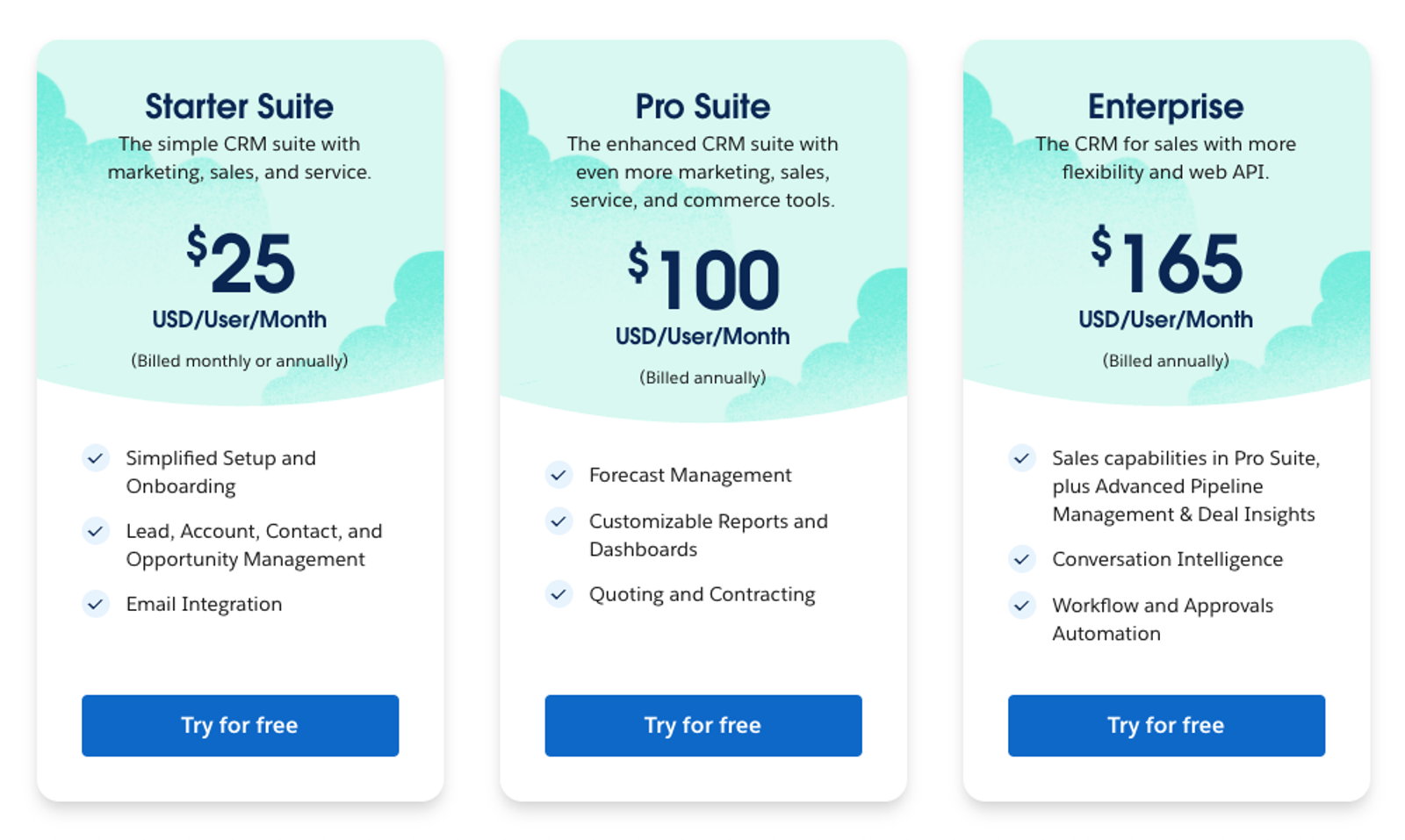
This monthly fee is in addition to the price you’re paying for Marketing Cloud Account Engagement.
Email marketing: the features you need vs. the same for a higher price
ActiveCampaign and Salesforce both offer segmentation that helps you divide your contacts into lists and send them relevant information when they’re approaching a buying decision.
Segmentation and personalization
To start, ActiveCampaign is known for granular segmentation, allowing you to create highly targeted lists based on behavior, location, purchase history, and much more. You can use advanced segmentation criteria like page visits, email engagement, and even lead scores, which means you can create very specific segments and reach the right audience with precise messages.
Let’s look a little deeper.
Tags in ActiveCampaign allow you to label contacts based on specific characteristics or actions. You might tag contacts as “Newsletter Subscriber,” “VIP Customer,” or even “Webinar Attendee.” These tags are highly customizable and let you easily group contacts for targeted marketing.

ActiveCampaign allows you to create custom fields that capture specific information about each contact, such as location, birthday, or preferences. You can then use this data to create more personalized messages. For example, you might create a custom field for “Favorite Product,” allowing you to tailor your emails around that specific interest.
You’ll also get to use dynamic segments. These are lists that automatically update based on set criteria. For instance, you could create a segment of contacts who opened an email in the past month. This feature ensures that your lists are always relevant without requiring constant manual updates.
ActiveCampaign’s predictive sending uses AI to analyze each contact’s past engagement and determine the best time to send an email. Instead of a one-size-fits-all approach, predictive sending customizes delivery times for each contact to increase the chances of an open, whether they’re most likely to check their email in the morning, afternoon, or evening.

This feature can really boost open rates and engagement since emails land in inboxes when recipients are most active. It’s a great tool for businesses looking to optimize timing without manual scheduling, helping campaigns perform better with little extra effort.
With ActiveCampaign’s conditional content, you can personalize specific sections of an email based on each contact’s data or behavior. For instance, if a customer has shown interest in a particular product category, you can set the email to display relevant product recommendations just for them.

This means different subscribers can see tailored messages, images, or offers in the same email, based on criteria like past purchases, location, or engagement level. It’s a powerful way to ensure each contact gets a message that feels uniquely relevant to them, boosting engagement.
ActiveCampaign’s dynamic content lets you personalize specific sections of emails based on each contact’s details, behaviors, or tags. For instance, you can show one message to new subscribers and another to returning customers within the same email.
Salesforce offers dynamic content but you’ll have to pay an extra $400/month to use it.
Finally, ActiveCampaign excels in behavioral segmentation, letting you target contacts based on actions they take, like opening emails, clicking links, or visiting certain pages on your website. This allows for real-time personalization, so you can follow up with relevant information or offers if someone engages with a product page.
Salesforce Marketing Cloud Account Engagement does offer segmentation, but they don’t do a very good job of advertising that. You can learn more about their segmentation here. Let’s take a look at what they offer.
Salesforce’s dynamic lists automatically update as contacts meet certain criteria. For example, you could create a dynamic list of leads who have opened an email in the past 30 days or visited a specific webpage. This ensures your segments stay up-to-date as leads’ behaviors change.

Their static lists are useful for one-time campaigns or when you want a fixed group of contacts. Unlike dynamic lists, they won’t update automatically, which can be helpful for specific outreach.
Salesforce also offers merge fields. This lets you add specific contact details—like names, company info, or custom data fields—directly into emails or landing pages, so every message feels personally crafted. For example, instead of a generic "Hello," you can greet contacts by name, making interactions feel more tailored and relevant.
Finally, Saleforce’s segmentation rules allow you to create one-time segments based on specific attributes or behaviors. For instance, you could filter contacts by industry, job role, or recent engagement and use these lists in tailored email campaigns. This makes it easier for marketers to send relevant, personalized content to different groups, helping increase engagement and conversion rates over time.
The takeaway: For smaller businesses or those looking for advanced segmentation and personalization without breaking the bank, ActiveCampaign generally offers better value for the price. Its ease of use and wide range of features make it a solid choice for businesses focused on personalization and engagement.
For large enterprises with complex needs, Salesforce’s higher-end features and deeper CRM integration might justify the higher price.
CRM: simple vs. overwhelming
ActiveCampaign includes a dedicated CRM add-on that’s integrated into the platform.
Contact management is central to their CRM, allowing you to store and organize customer data in a central location. You can track each contact’s interactions, purchases, and engagement with your emails or website. Plus, custom fields let you capture specific information about each contact, which helps tailor your communication and create more personalized experiences.
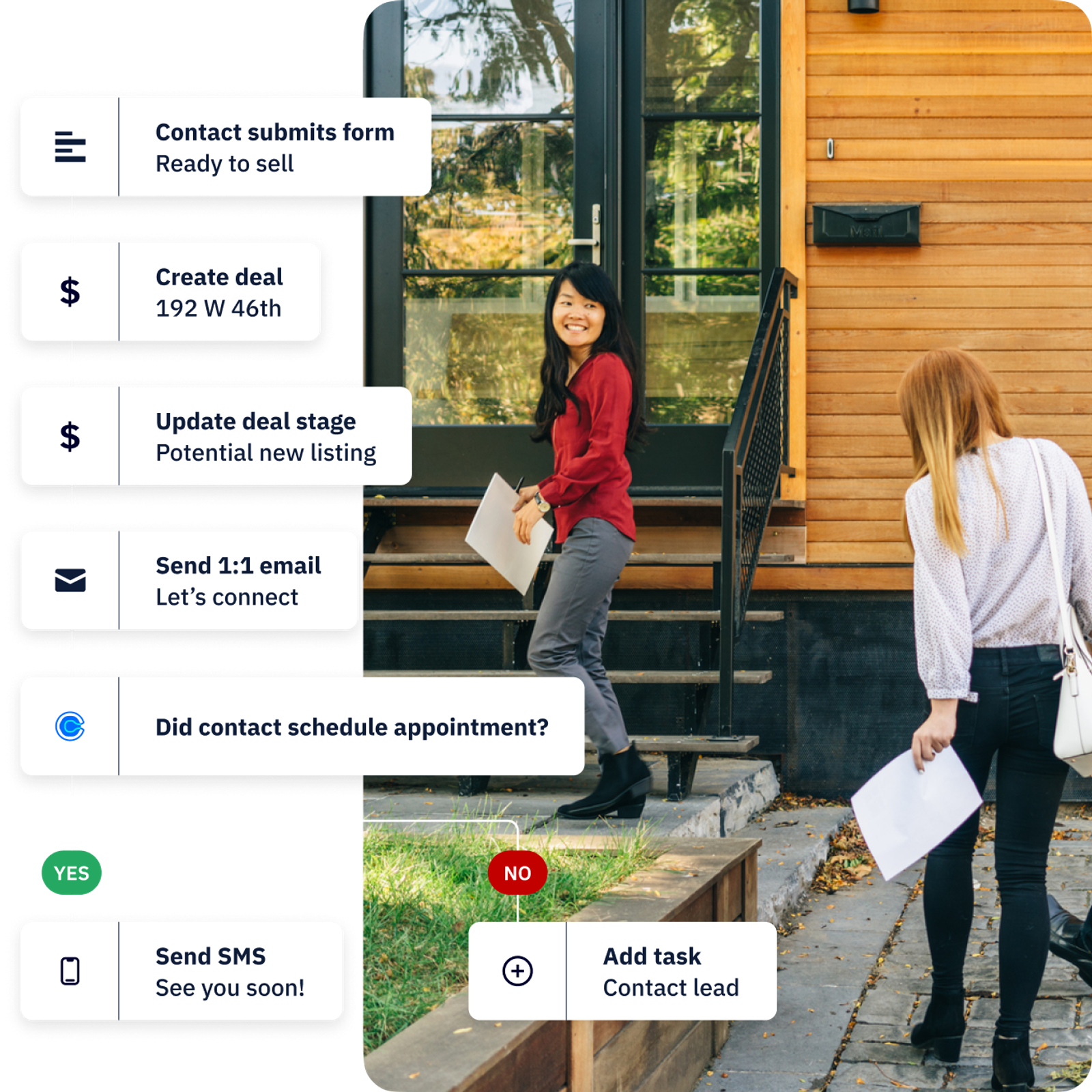
Their pipeline management allows you to visualize and manage the stages of your sales process, helping sales teams track and move leads through different stages like "New Lead," "Qualified," or "Closed Won." This keeps everything organized and ensures that no opportunity is missed.
Finally, ActiveCampaign’s CRM includes deal tracking and task management to keep your sales process moving smoothly. You can assign tasks to team members, set reminders, and track deal progress from start to finish. The activity timeline gives you a complete view of each contact's journey, including past communications, opened emails, and any sales activities. This level of detail is powerful for sales teams, as it ensures they have all the information needed to close deals effectively.

Integration with the broader ActiveCampaign platform allows your CRM to work alongside your marketing automation tools, giving you a totally unified experience.
Key features of ActiveCampaign’s CRM:
- Send a notification or Slack message when a contact’s information changes or they complete specific actions.
- Track and divide up the sales outreach process between different members of your team.
- Set up automations to send relevant content to your customers based on things like order size or response times.
- Use Kanban-style boards to visualize sales opportunities.
- ActiveCampaign’s lead scoring helps you find the most promising opportunities based on your prospects’ actions and behaviors.
- The deal scoring feature gives each of your deals a numerical value so you can understand which deals are a priority.
- Use automations to create and modify deals in the CRM based on the data you’ve already collected from each contact.
Salesforce’s CRM within the Marketing Cloud Account Engagement plan offers tools to manage customer relationships and streamline sales and marketing efforts. One of the core features is lead management, which allows you to track and nurture leads throughout their journey. The system uses lead scoring to rank leads based on their interactions with your marketing materials, helping sales teams prioritize high-value prospects.
Another key feature of Salesforce’s CRM is its segmentation and targeting capabilities. You’re able to create dynamic segments based on customer behavior, demographics, and engagement. This allows marketers to deliver highly personalized content and campaigns. The CRM integrates seamlessly with Salesforce's broader ecosystem, making it easy to pull data from various sources, like previous sales interactions or customer support inquiries.
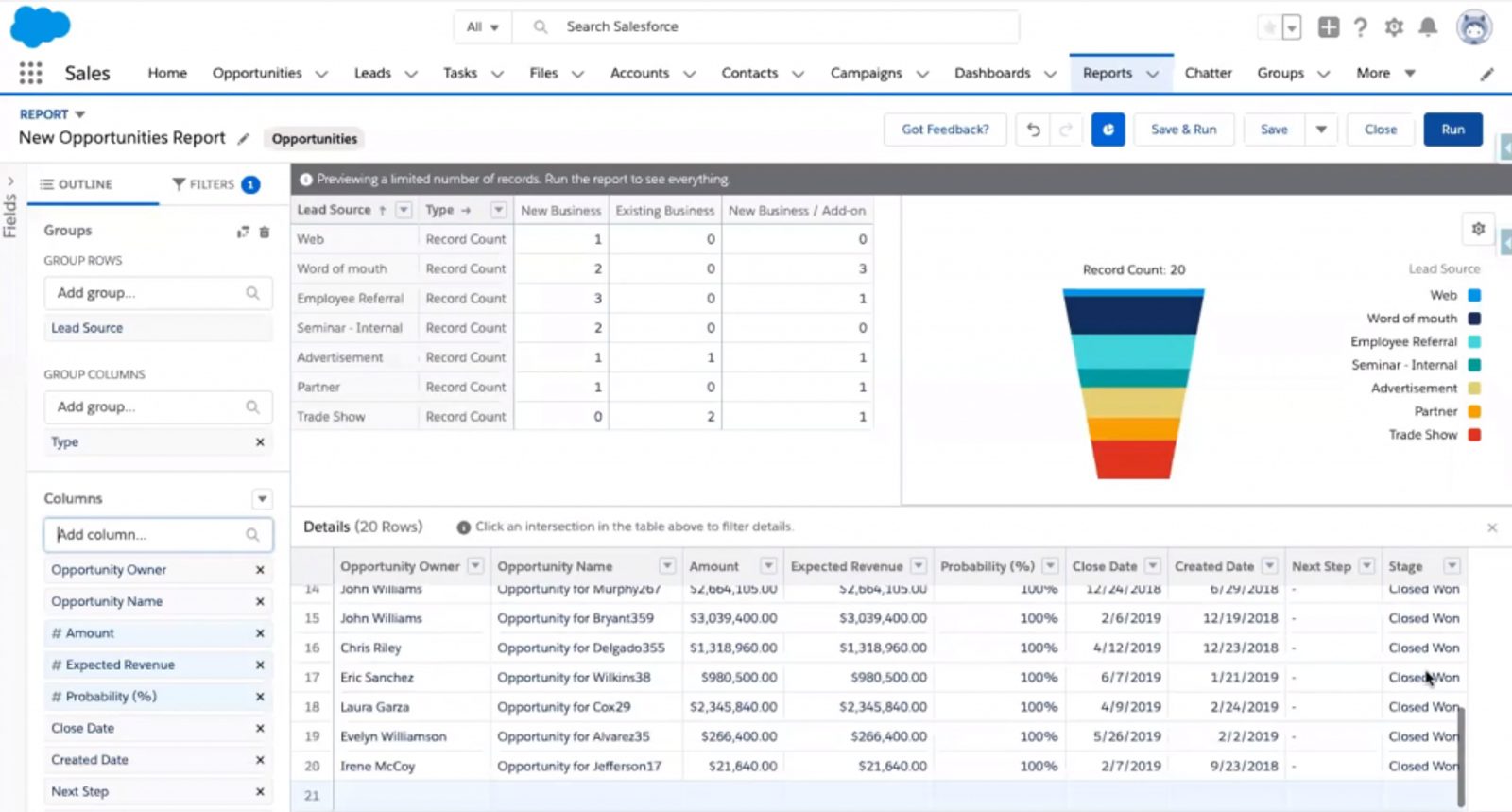
This ensures that your messaging and offers are tailored to each customer’s unique preferences and history with your brand.
Salesforce’s CRM also offers automation and workflow management that make it easier to automate repetitive tasks and ensure that the right actions are taken at the right time. You can automate responses, follow-up emails, and task assignments based on a customer’s actions or lead score. This automation not only saves time but ensures that no opportunities slip through the cracks.
Integrations
In ActiveCampaign’s app marketplace, you’ll find 950+ apps that integrate with various tools and platforms, including CRM systems, e-commerce platforms, and other marketing tools. It supports connections with popular services like Salesforce, Shopify, WooCommerce, and hundreds more.
Salesforce offers a broad array of integrations across various platforms, with over 2,500 options available through their AppExchange, connecting everything from CRMs and analytics tools to social media platforms and customer service apps. These integrations include platforms like Mailchimp, Slack, and Dropbox.
The platform that’s right for you will ultimately come down to which tools you’re already using and how easily ActiveCampaign or Salesforce integrates with them.
Email templates: clear and customizable vs. complex
ActiveCampaign offers 250+ pre-built templates with advanced editing options and the ability to save reusable content blocks. These templates are fully customizable, allowing users to adjust layouts, colors, fonts, and content to match their branding. The drag-and-drop email designer makes this process accessible, even for those with minimal design experience.
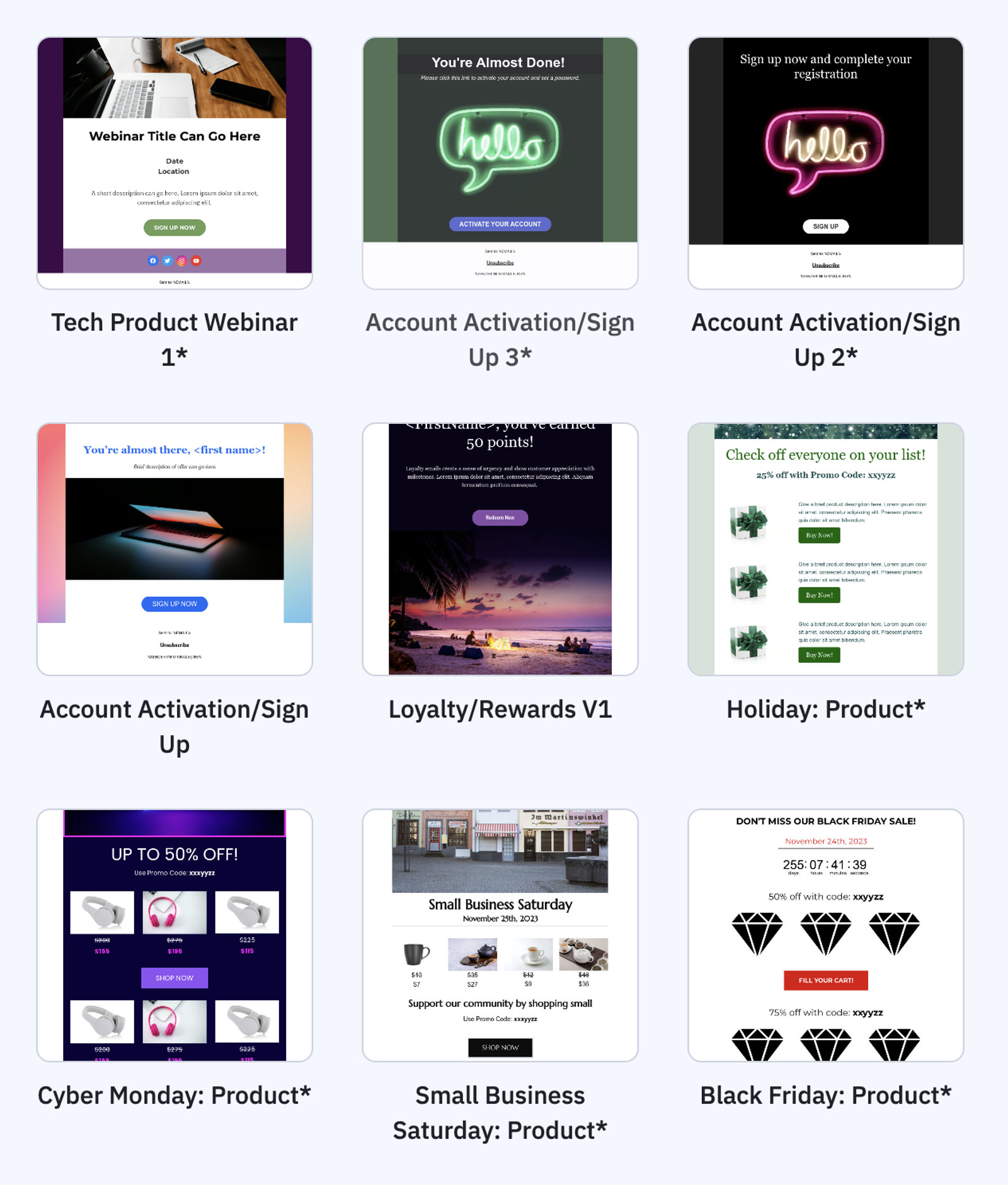
Plus, these templates can be tailored with conditional content, allowing more complex designs that adapt to each contact’s information.
ActiveCampaign’s email templates allow you to:
- Create beautiful email messages, newsletters, and entire email campaigns in just a few clicks
- Build quickly with responsive templates, all the code, design, and QA built right in
- Use the AI BrandKit to import colors, fonts, and logos from your website to generate on-brand email templates, content, and images
- Use all ActiveCampaign templates on any plan tier
Salesforce Marketing Cloud Account Engagement also offers email templates, though the exact number is unclear and can depend on your specific plan or customization.
Salesforce provides a selection of customizable templates with options for conditional content and dynamic fields, but it’s generally considered a more complex setup and use.
The takeaway: Both platforms offer email templates, but ActiveCampaign makes it easier to customize and get started quickly, especially for smaller businesses or teams without a dedicated design resource. While offering powerful customization, Salesforce might require a bit more technical know-how to take full advantage of its features.
Reporting: clear and actionable vs. complexity for big teams
Both ActiveCampaign and Salesforce offer a range of reporting tools that give you deep insights into your marketing campaigns. One of the standout features is the Marketing Revenue Report, which ties your marketing efforts directly to revenue. This report shows exactly how your campaigns impact your bottom line, making it easier to see what’s working and where you might need to make adjustments.
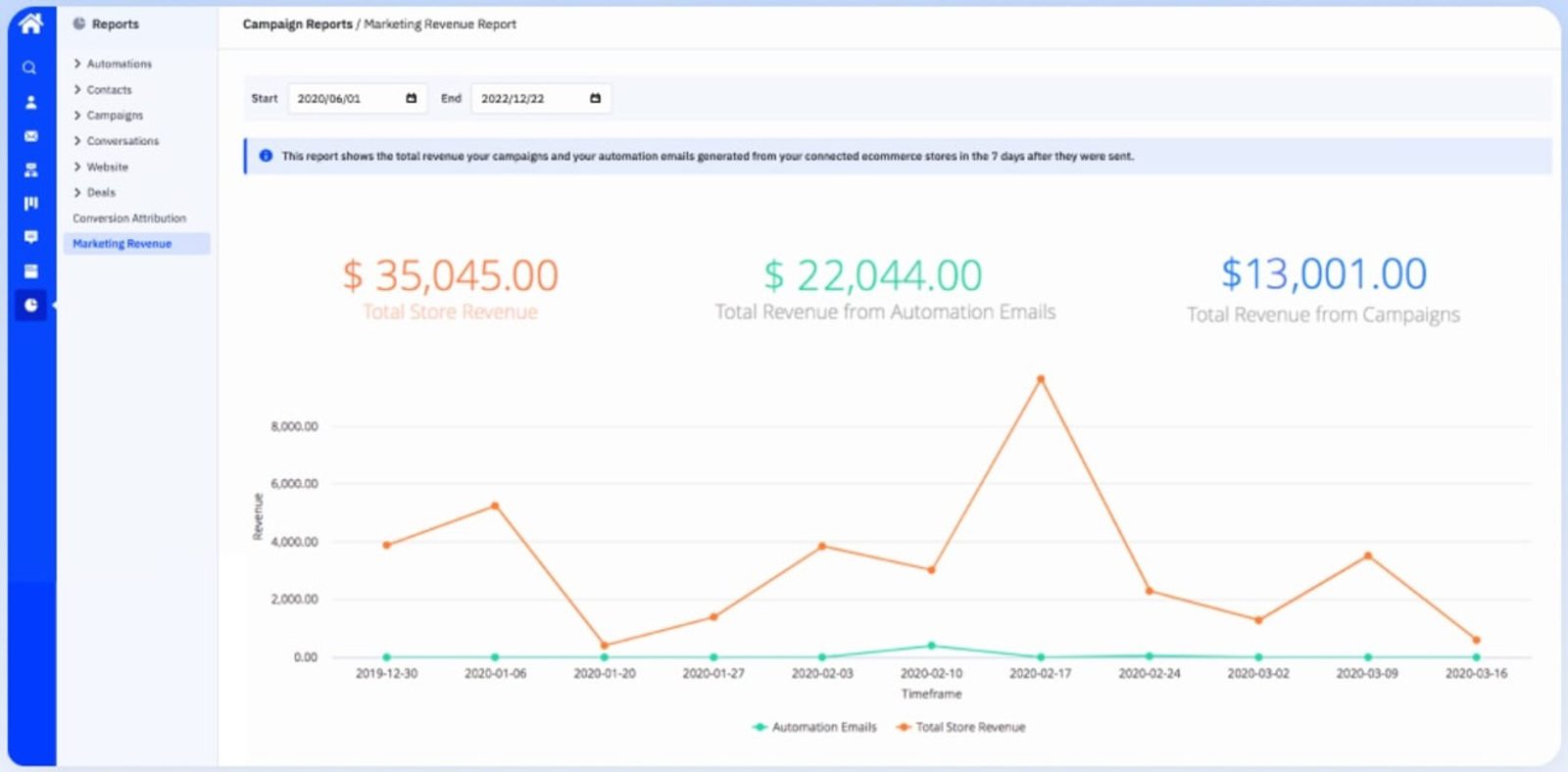
ActiveCampaign’s Marketing Revenue report helps you directly link your marketing activities to actual sales, giving you a clear picture of your ROI.
A few of the key features you’ll get with ActiveCampaign’s Pro plan:
- Campaign performance reports: After sending out a new email campaign, you can use ActiveCampaign's reporting tools to quickly analyze its performance. For example, if you notice a high open rate but low click-through rate, this data can help you adjust your subject lines or calls to action for future emails. It's perfect for real-time adjustments when you're testing different messages or promotions.
- Automation reports: If you're running an automation sequence, such as an onboarding flow for new customers, you can track how each step is performing. If you find that users are dropping off after the second email, you can tweak the messaging or timing. These insights allow you to refine your strategies on the fly to improve conversion rates.

- Custom reports: Say you're interested in how specific segments of your audience (like repeat customers) interact with your emails. ActiveCampaign allows you to create reports tailored to those groups so you can dive deep into behavior patterns, optimize content for them, and track specific engagement metrics like purchase behavior.
- Real-time data: You can track the performance of an email campaign immediately after launch. This feature is ideal for marketers who want to see how their audience reacts to a particular offer and make necessary adjustments, like adjusting send times or follow-up sequences.
Key features of ActiveCampaign reporting:
- Use first-party data and ActiveCampaign’s industry expertise to score your performance and determine next steps.
- Filter out unreliable metrics and click fraud to ensure data accuracy.
- Use ActiveCampaign’s real-time reporting toolkit to spot trends, find new opportunities, and uncover actionable data about your customers.
- Predict how likely a deal is to close with win probability.
- Bring data in or send data to any app with over 900 integrations.
Salesforce’s reporting is designed for those who need comprehensive, cross-channel insights and are willing to navigate more complex tools for deeper data analysis.
A few of the key features you’ll get with Salesforce Marketing Cloud Account Engagement:
- Comprehensive reporting dashboard: Suppose you're a marketing manager running campaigns across email, social media, and web ads. Salesforce’s dashboard lets you monitor all of these channels in one place. For example, if a certain email campaign is driving more traffic to your website, but your social media ads aren’t performing as well, you can adjust the budget or messaging for that channel.
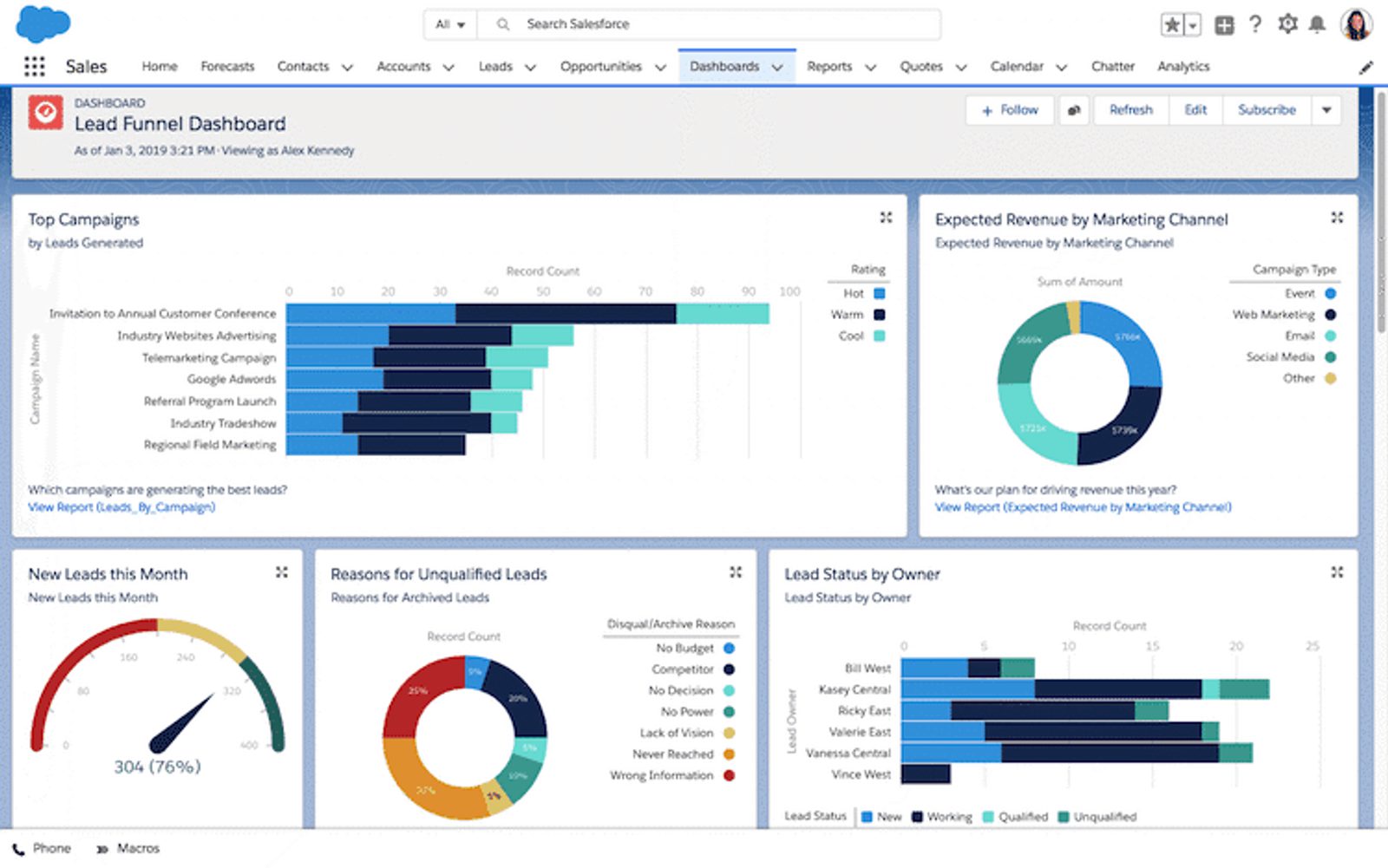
- Cross-channel reporting: If you're running multiple touchpoints for a single campaign (like emails, landing pages, and social ads), Salesforce gives you insights into how each of these channels is contributing to your overall goal. This helps you understand where customers are interacting the most so you can refine the journey to ensure a seamless experience across platforms.
- Advanced segmentation insights: Imagine you have a product launch, and you want to understand how different customer segments are reacting to your emails. Salesforce can break down your results by different customer groups so you can see how loyal customers versus new ones are engaging with the content. This helps you tailor your campaigns more effectively for each group.
- Customizable reports: For a company with a complex sales funnel, Salesforce allows you to create highly detailed reports, like tracking leads from initial email contact through to closed deals. This type of reporting is essential for teams that need to measure the performance of long-term, multi-step campaigns.
The key takeaway:
ActiveCampaign is ideal for small to mid-sized businesses or teams that need quick, actionable insights to improve their campaigns on the go. Its user-friendly but deep reporting capabilities are designed for marketers who need to test, tweak, and optimize quickly without getting bogged down in technicalities.
Salesforce shines when you need a deeper, cross-channel view of your campaigns. It’s a good fit for larger teams running complex marketing strategies across multiple touchpoints. The ability to track and analyze data from different platforms in one place helps marketing and sales teams collaborate more effectively and optimize their efforts.
Pricing comparison
ActiveCampaign and Salesforce have vastly different pricing structures. For this comparison, we’ll look at Saleforce’s Marketing Cloud pricing and all four of ActiveCampaign’s pricing tiers. Both platforms include advanced marketing automation, a powerful CRM, and a centralized location for your customer data so you can connect your marketing and sales efforts.
Salesforce pricing
Before diving into pricing, it’s helpful to get a baseline on how Salesforce organizes their products and how you can customize every element of your plan. This makes it nearly impossible to provide an estimate on what your unique Salesforce plan will cost you.
Information from their pricing page
“Marketing Cloud is the platform name for a range of products that help marketers achieve success across every aspect of the marketer’s role. The platform is sold through individual products that make up the entire portfolio, including our Data Cloud, Engagement, Personalization, and Marketing Intelligence solutions. Each product can be sold depending on the individual businesses needs, and are priced to cater for every business size and need.”
The Growth tier is the closest in comparison to ActiveCampaign’s Pro plan. Even so, you start with a steep price from the get go.
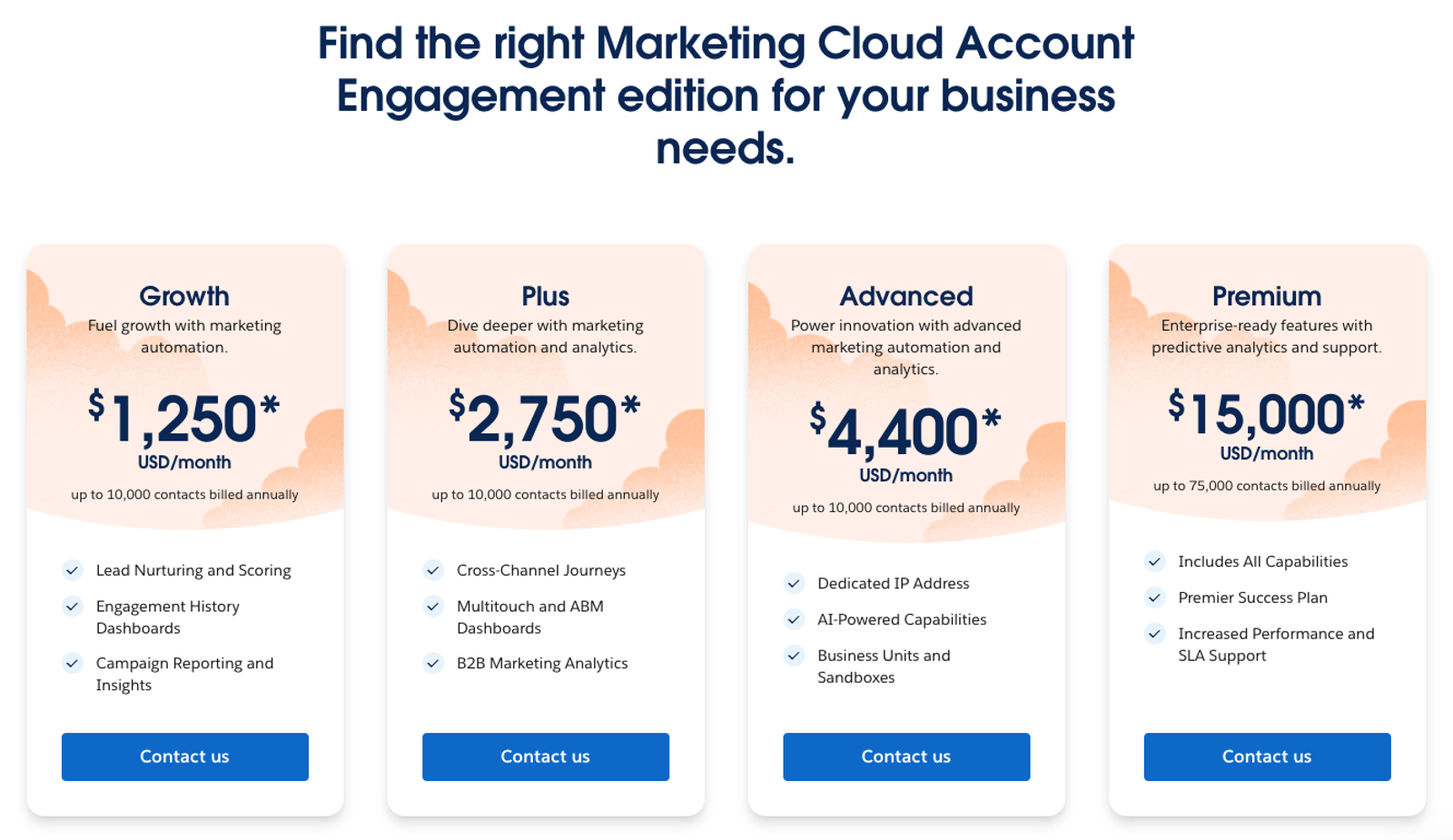
Pricing is based on up to 10,000 contacts.
Salesforce Marketing Cloud Account Engagement has four tiers: Growth, Plus, Advanced, and Premium.
For the Growth plan, you get up to 10,000 contacts per month with the following features:
| Lead generation, qualification, and management | Advanced email analytics, rending, and preview analysis (extra $400/month) |
|---|---|
| Email marketing and personalization | Dynamic content (extra $400/month) |
| Unlimited email marketing | Tracked social posts |
| 50 forms | 50 landing pages |
| Integrated marketing calendar | Email A/B testing |
| Automation rules | Merge fields |
| Engagement programs | Lead nurturing |
| Prospect tracking | Lead scoring and grading |
| 5 engagement history dashboards | Multivariate landing page testing |
| ROI reporting | Customizable URLs |
The Plus plan dives deeper with marketing automation and analytics and starts at $2,750/month for up to 10,000 contacts.
With the Plus plan, you get everything in Growth plus these features:
| Advanced automation, personalization, and qualification | Custom object integrations (extra $400/month) |
|---|---|
| Advanced analytics and reporting | 100 automation rules |
| Unlimited landing pages | Advanced dynamic content |
| Multiple lead scoring categories | 10 engagement history dashboards |
| Advanced email analytics, rending, and preview analysis | 10 external activity active extensions |
| Multi-touch attribution models | A dedicated IP address (extra $500/month) |
| API access - 50,000 calls/day |
Salesforce’s Advanced plan climbs to $4,400/month for up to 10,000 contacts.
With the Advanced plan, you get everything in the Plus plan plus these features:
| Business units and developer sandboxes | 150 automation rules included |
|---|---|
| 20 external activity active extensions | 20 engagement history dashboards |
| Einstein AI | 2 business units |
| API access - 100,000 calls/day | Custom object integration |
| Custom user roles and permissions | 2 developed sandboxes for account engagement |
| A dedicated IP address |
Finally, Salesforce’s Premium plan is a whopping $15,000/month for up to 75,000 contacts. It has enterprise-ready features with predictive analytics and support.
With the Premium plan, you get everything previously mentioned, plus:
| 30 external activity active extensions | Premier Success |
|---|---|
| Predictive analytics and personalized product support | 5 sandboxes for account engagement |
| 5 business units |
ActiveCampaign pricing
ActiveCampaign’s entry-level pricing is eight times more affordable than the entry-level Salesforce Marketing Cloud plan.
Compared to similar enterprise-level marketing automation tools like HubSpot or Salesforce, ActiveCampaign is pretty budget-friendly for the amount of features you get. They don’t offer a free plan (just a free two-week trial), but their Starter plan gives you access to some pretty advanced features for only $15/month.

Prices above are based on a max of 10,000 contacts.
ActiveCampaign’s entry-level pricing starts at $15/month for 1,000 contacts. This plan, aptly named the Starter plan, gives you access to multi-step marketing automation right out of the gate. Salesforce doesn’t advertise advanced automation on any of their plans.
With ActiveCampaign’s Starter plan, you get access to features like:
| Email sends 10x contact limit | 900+ automation recipes |
|---|---|
| 5 actions and triggers per automation | An AI-powered automation builder |
| Email campaigns and newsletters | Limited reporting and analytics |
| Basic and inline web forms | Limited segmentation |
| Over 250 email templates | Site tracking |
| Over 950 integrations including standard e-commerce apps | The ActiveCampaign Marketing CRM |
| A/B testing on emails |
Moving up to the Plus plan, you unlock more automation and powerful customer insights for $189/month with 10,000 contacts.
The Plus plan adds features like:
| Landing pages (and templates) | Generative AI functionality |
|---|---|
| Unlimited triggers and actions for your automations | Prospecting and retargeting ads for Google, Facebook, and LinkedIn |
| Web forms | Basic segmentation |
| Basic reporting and analytics | Revenue reporting |
With the Plus plan and up, you can add on the pipeline enhanced CRM to manage your sales automation or the sales engagement CRM that includes additional email and AI capabilities.
ActiveCampaign’s Pro plan will cost you $375/month with 10,000 contacts. With it, you unlock full omnichannel marketing automation. This is where you can truly elevate your email marketing. Your monthly email sends are 12x your contact limit, and you’ll get three users instead of one.
The Pro plan gives you access to additional features like:
| A/B testing on automations | Conditional content |
|---|---|
| Advanced segmentation, reporting, and analytics | Attribution and conversion tracking |
| Predictive sending |
The Pro plan allows you to get more granular about how your email campaigns are performing and understand what content, messaging, and offers move the needle for your business. You’ll have total control over your email cadence.
Finally, ActiveCampaign’s Enterprise plan starts at $589/month for 10,000 contacts and allows you monthly email sends 15x your contact limit plus five users.
With the Enterprise plan, you get everything previously mentioned, plus:
| Premium segmentation | Custom objects |
|---|---|
| Premium CRM integrations with Salesforce, Microsoft Dynamics, and more | Premium reporting and analytics |
| Single sign-on (SSO) | And a dedicated account team |
No matter which ActiveCampaign plan you choose, ActiveCampaign offers services like contact migration, customer enablement workshops, chat and ticket support, video tutorials, a knowledge base, and help guides to help you get the most out of the platform so you can focus on running your business.
Overall, ActiveCampaign’s pricing is much more accessible for businesses of all sizes. The features included are incredibly powerful without any extra hidden fees like you’d run into with Salesforce.
ActiveCampaign or Salesforce: which is best for you?
The platform you choose will depend on which features above are most important to you (and which you need to grow your business).
Choose ActiveCampaign if you’re a small to mid-sized business looking for a straightforward and intuitive solution to drive marketing automation, email campaigns, and CRM needs.
ActiveCampaign is ideal for teams that need to quickly get up and running without needing technical expertise, as well as those who prioritize simplicity and value for money.
Choose Salesforce if you’re a large organization or enterprise that requires in-depth data analysis, cross-channel marketing, and highly customizable solutions.
Salesforce is well-suited for businesses with complex workflows and diverse teams that need a powerful platform to manage everything from customer engagement to detailed reporting and automation.
What are real customers saying about each platform?
Are customer stories too biased for you? We get it. Let’s look at a few reviews from real users.
| Pros: This platform really extends the functionality of Salesforce and its data to a whole other level. Having insights into what your customers, contacts, leads, etc. are doing across multiple channels is marketing gold. | Cons: It's not cheap. You do get what you pay for but in reality it will be out of reach for most sub $100MM companies. Occasionally there is some inconsistencies between data across the Account Engagement and the base Salesforce platforms. |
|---|
| Pros: The deals feature is increibly intuative. We were able to roll AC out to our sales team who had stopped using any CRM 10 years prior. It was an easy trasition thanks to a beautiful interface, endless resources with the education center, and responsive customer support. ActiveCampaign is well suited to scale, too. It's small enough to be an easy on-ramp for a small company but can scale to any size. | Cons: I started on AC with a small company. I would have loved to get more included traning or personlized deals pipelines to help get the ball rolling. Integration was incredible easy, but I would have loved more help with getting started. |
|---|
Frequently asked questions
Lingering questions? We've got you.
💡 Who is ActiveCampaign best for?
ActiveCampaign is ideal for businesses that want to take their marketing to the next level with powerful automation and personalization features. It’s a great fit for small to mid-sized teams who need advanced tools to automate their marketing, segment their audience, and track detailed performance metrics.
If you're looking for a platform that offers deep customization, predictive analytics, and a visual workflow builder to create tailored customer experiences, ActiveCampaign could be a perfect match. It’s especially useful if you have a bit of experience with email marketing and want to leverage more sophisticated strategies to drive growth.
💡 Can you use ActiveCampaign as a CRM?
Yes, ActiveCampaign can be used as a CRM. It includes built-in CRM functionalities that allow businesses to manage their sales pipelines, track customer interactions, and automate follow-ups.
The combination of marketing automation and CRM in one platform helps simplify the sales process, improve customer engagement, and maintain organized records of customer data and interactions, making it easy to manage your marketing and sales in one place.
💡 What is the difference between Salesforce and ActiveCampaign?
The key difference lies in their target audience and complexity. Salesforce is a highly customizable, enterprise-level platform ideal for large organizations with complex needs, offering deep analytics, cross-channel marketing, and CRM tools. It’s suited for businesses requiring extensive reporting, integration with other tools, and scalability.
ActiveCampaign, on the other hand, is better for small to mid-sized businesses seeking an intuitive and cost-effective solution for email marketing, sales automation, and CRM without the complexity of Salesforce. ActiveCampaign offers a more user-friendly interface and affordable pricing, making it great for teams that need quick setup and easy-to-use tools for growth.
💡 Is Salesforce best for email marketing?
Salesforce is a powerful platform, but it may not be the best choice solely for email marketing, especially when compared to more specialized tools. While Salesforce Marketing Cloud provides comprehensive email marketing features like advanced segmentation, personalization, and automation, its core focus is on enterprise-level marketing and customer engagement across multiple channels.
Its email marketing capabilities can be complex, requiring significant setup and customization, which might be overkill for small to mid-sized businesses or those focused only on email campaigns. If your primary goal is email marketing and you're looking for ease of use, ActiveCampaign is often a more practical solution.